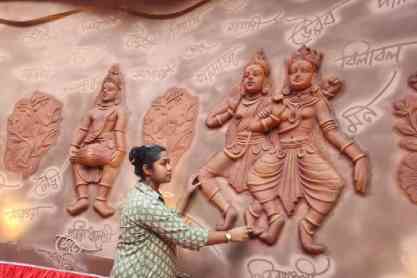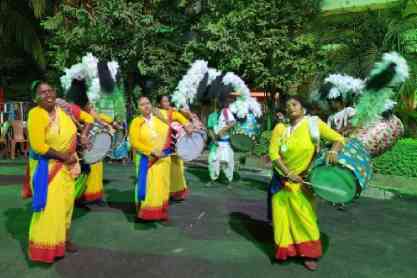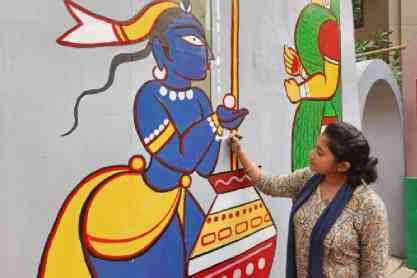Feminine touch at pandals
For a city that hosts innumerable theme pujas, too few are crafted by women. In Salt Lake this year, the AD Block pandal was headed by a woman theme maker and in AG Block, most of the work was done by a woman, who was part of a husband-wife team of artistes.
“Before finalising our theme makers, we had spoken to 39 artistes,” said AG Block’s puja’s joint secretary Arnab Kundu. “We had liked Aditi Chakraborty’s work but she lives too far from Salt Lake and has a young child, so declined. She suggested Sumi Majumdar-Subhadip Majumdar instead and we are delighted with the music-themed pandal they crafted.”
While the Sumi-Subhadip couple takes on projects as a team, they divide the pujas among themselves. Sumi was in charge of AG Block. “You can see a woman’s touch in our pandal. Sumi also briefed our sculptor and music composer to synergise with the theme,” said Kundu.

Sumi Majumdar gives finishing touches to a figurine at the AG Block pandal
Sumi knows of only five or six other women in the industry. “Many start work but are forced to discontinue as this job is mentally and physically laborious. Some give up due to health reasons or lack of family support. We have to spend the night at pandal sometimes. I have a three-year-old son and am lucky my mother-in-law looks after him. Men don’t have to worry about such things,” said the Behala resident.
At AD Block, theme maker Madhurima Pal’s crew of 15 had about 10 women and she dreams of pulling off a puja pandal built entirely by women. “There are challenges,” she said. “Besides obvious ones like having the strength to tie bamboos together, some women are uncomfortable climbing ladders. I am yet to see a woman hammering nails or doing the painting work at pandals too. Salt Lake has good infrastructure but not all clubs have proper toilets. Some women are not allowed by their families to stay at pandals overnight.…”
Subhechchha Bhunia, who worked with Madhurima at AD Block, says she’s lucky to have got such a chance. “Many artistes think women can’t slog like men, can’t climb ladders….” she said, before hopping onto one to complete a Jamini Roy replica on the wall a few days before opening.
Another artiste at AD Block, Monisha Majhi, said women were perfectionists. “But what makes me sad is that when visitors learn a pandal is made by women, they are more shocked than appreciative,” she said. “It’s as if they don’t expect excellence from women.”
Arya Ganguly, secretary of the block association, said their committee took pride in encouraging young women to make their pandal. “Not only are they talented, but they are also much cleaner and tidier than men,” he said.
Madhurima has been designing pandals since 2020 but still, she says, organisers doubt the worth of her woman-heavy crew. “Most women need to be part of a husband-wife combo of theme makers before clubs show faith in them. This is why I need to pull off a pandal by a women-only team,” she said. “I want parents to walk into such a puja and reflect that if women can build something so grand, why not their daughters,” she said.
Making sense of mantras
The slokas at AG Block’s puja this year were translated to Bengali for devotees. The pranam mantra during anjali was in the words of Tagore and sandhi puja was performed alongside Nazrulgeeti. And implementing these innovations were four progressive priests — nay, priestesses.
The Durga puja at AG Block was conducted by women priests. They were part of Shubhamastu, the initiative for priestesses started by Nandini Bhowmik, on whose struggle the 2020 film Brahma Janen Gopon Kommoti was based. Though Bhowmik herself was conducting puja at 66 Palli, her team was in Salt Lake and she had herself come beforehand to supervise the arrangements.
“Shubhamastu has four teams of four. Two of us in each group conduct the rituals and the other two sing songs from the Samaveda and by panchakobi,” said Sumana, one of the “singers” at the AG Block puja. She, and the other members, do not disclose their surnames as that would reveal their castes. This is another glass ceiling the women are breaking. Though traditionally only those born into Brahmin families perform puja, the women reason that anyone with the right education and devotion is eligible.

Women priests perform puja at AG Block
“We have scrutinised the scriptures and found it mentioned nowhere that women may not perform puja,” said Amrita who, along with her team, had been training for Durga puja since May. “We also perform weddings, Lakshmi puja, Kali puja, griha pravesh, shradh... We only decline poite as the concept widens the cast divide.”
The women follow a script written by Bhowmik. “For instance, besides reciting mantras, we translate them to Bengali, English or Hindi. At weddings, we avoid the kanyadaan and the bride takes a pinch of sindur from her head and applies a tilak on the groom, as a mark of equality,” says Tithi.
During Durga puja the pranam mantra for anjali was, in fact, the poetry from Tagore’s Antar mama bikashito koro. Nazrul’s Elo re elo oi ranarangini was the backdrop for sandhi puja.
“Nandinidi started out by performing her own daughter’s wedding in 2009 but she had to face resistance. Today, especially after the 2020 movie, people are appreciative and encouraging,” said Sumana.
It is after the movie that Bhowmik was invited by 66 Palli to perform Durga puja for the first time. This year, all four of their teams performed puja, one even in the Netherlands, and Bhowmik had trained two additional groups abroad, online.
For AG Block, this was the first year with women priests. “From last year, we are inviting women dhakis and this year we are proud to have women priests. Their method was different and the residents unanimously welcomed them,” said cultural secretary Shriya Biswas.
At weddings, guests have told the priestesses that they wish they could get married again, under them. At funerals guests have hoped that their own last rites are performed by them. But the women also have to endure criticism. “At weddings, priests from the other side challenge our knowledge or try to dominate us at times. But Nandinidi tells us to keep our cool,” says Rita, who teaches at Jadavpur University. The minimum requirement to be priests at Shubhamastu is an MA in Sanskrit.
“It is also wrong to stop women from performing puja when they menstruate,” says Bhowmik. “Women still go to work, feed children and care for elders on their period, isn’t it? Is that not puja? Does god reside only inside the thakur ghor?”
She recalls the mantra that is recited before Durga puja — Om apavitra pavitro... “It says that anyone who remembers Narayan — man or woman — is purified, then why the discrimination?” she asks.
But Bhowmik acknowledges that it is difficult for society to change. “It’s only because of lack of education that women were kept away from performing puja thus far. But superstitions have been passed down for generations and there are sentiments that have come to be attached to them. If we challenge these, there could be opposition but we need to be calm. I counsel the ladies I work with for what they might encounter. It is important to be convinced that what we are doing is right.”
Drumming their own beat
AG Block went the whole distance this year and, besides women priests and theme maker, also had women dhakis setting the tone for their festivities. While women dhakis are quite common now, it wasn’t the case in 2014, when Chitra Mahila Dhaki Goshti, of a Burdwan village started out.
“I was married off at 14, had a son at 15, and lost my husband soon after. I lived off odd jobs, including working as domestic help before I heard that women were now becoming dhakis,” said Chitra Das, who then got dhaki Bablu Das to teach her. But to raise a team, she had to go door-to-door.
“Respectable women in our village wouldn’t work and I was ridiculed for trying to do a man’s job,” said Das. “Neighbours said it wasn’t right for women to stay away from home, that we would be harassed by drunkards during the immersion procession.... But I convinced the women saying that if they made their own living, they wouldn’t have to depend on their husbands for everything,” said Das.

Women dhakis perform at AG Block
“Back then coming to Calcutta seemed like crossing an ocean but now we’re here all the time, performing at weddings, annaprashans and political meetings. We even visit Assam and Tripura,” said Parbati Das, who was a homemaker before becoming a musician. “We return home with interesting stories and generous tips that keep us alfoat. We are happy.”
Dhaki Bablu Das, who taught them and now travels with them, has faith in the women. “The ladies are dedicated. They can play up to an hour and a half at a stretch despite the dhak feeling heavy on their shoulders,” he says.
